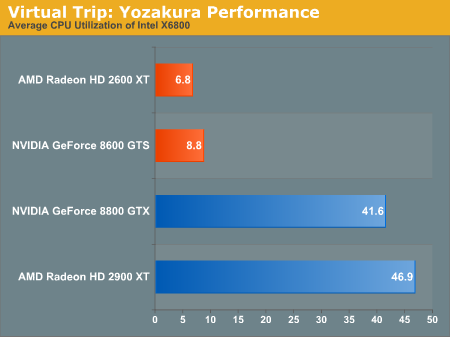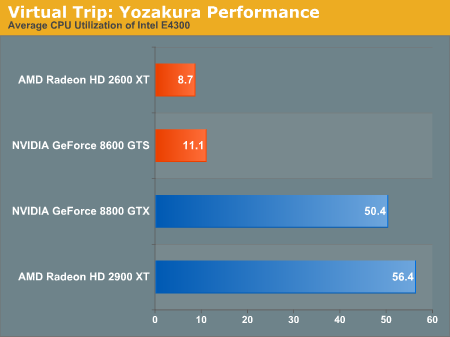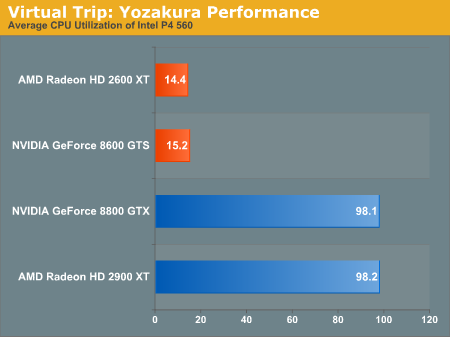HD Video Decode Quality and Performance Summer '07
by Derek Wilson on July 23, 2007 5:30 AM EST- Posted in
- GPUs
Yozakura (High Complexity H.264) Performance
H.264 offers quite a range of options, and we haven't seen everyone taking advantage of some of the more advanced features. Yozakura is encoded in 1080i at 25 Mbps. This is fairly low for H.264 maximums, but this is still very CPU intensive because the video is encoded using macroblock adaptive frame/field (MBAFF) coding. MBAFF is a high quality technique to ensure maximum visual fidelity in interlaced video by adaptively selecting frame or field encoding per macroblock based on a motion threshold.
While 1080p is clearly Hollywood's choice of resolution, there is 1080i encoded content out there now and more likely to come. As TV shows transition to HD, we will likely see 1080i as the choice format due to the fact that this is the format in which most HDTV channels are broadcast (over-the-air and otherwise), 720p being the other option. It's nice to know that H.264 offers high quality interlaced HD encoding options, and we hope content authors who decide to release their creations in 1080i will take advantage of things like MBAFF.
Additionally, good deinterlacing is essential for getting a good experience with movies like this. Poorly deinterlaced HD content is not only sad to watch, but gives this author quite a headache. Jaggies and feathering are horrible distractions at this resolution. As long as you stick with an HD 2600 or GeForce 8600 series or higher you should be fine here. Any slower just won't cut it when trying to watch 1080i on a progressive scan display.

Our high end CPU is able to cope fairly well, with the 8800 GTX besting the 2900 XT in performance while UVD leads VP2 putting the 2600 XT ahead of the 8600 GTS.

For our cheap yet current processor, we do see utilization go up, but the hardware with bitstream decoding maintains very low overhead. All of our GPUs maintain good performance when paired with this level of processor. Of course, we would likely not see the high end GPUs matched with such a CPU (unless we are looking at notebooks, but that's a whole other article).

For our older hardware, Yozakura is simply not watchable without bitstream decoding. With the numbers for the high end AMD and NVIDIA GPUs even worse than under our Transporter 2 trailer test, it's clear that NetBurst does not like whatever Yozakura is doing. It may be that decoding the bitstream when MBAFF is used is branch heavy causing lots of stalls. All we can say for sure is that, once again, GPU accelerated bitstream decoding is necessary to watch H.264 content on older/slower hardware.
H.264 offers quite a range of options, and we haven't seen everyone taking advantage of some of the more advanced features. Yozakura is encoded in 1080i at 25 Mbps. This is fairly low for H.264 maximums, but this is still very CPU intensive because the video is encoded using macroblock adaptive frame/field (MBAFF) coding. MBAFF is a high quality technique to ensure maximum visual fidelity in interlaced video by adaptively selecting frame or field encoding per macroblock based on a motion threshold.
While 1080p is clearly Hollywood's choice of resolution, there is 1080i encoded content out there now and more likely to come. As TV shows transition to HD, we will likely see 1080i as the choice format due to the fact that this is the format in which most HDTV channels are broadcast (over-the-air and otherwise), 720p being the other option. It's nice to know that H.264 offers high quality interlaced HD encoding options, and we hope content authors who decide to release their creations in 1080i will take advantage of things like MBAFF.
Additionally, good deinterlacing is essential for getting a good experience with movies like this. Poorly deinterlaced HD content is not only sad to watch, but gives this author quite a headache. Jaggies and feathering are horrible distractions at this resolution. As long as you stick with an HD 2600 or GeForce 8600 series or higher you should be fine here. Any slower just won't cut it when trying to watch 1080i on a progressive scan display.

Our high end CPU is able to cope fairly well, with the 8800 GTX besting the 2900 XT in performance while UVD leads VP2 putting the 2600 XT ahead of the 8600 GTS.

For our cheap yet current processor, we do see utilization go up, but the hardware with bitstream decoding maintains very low overhead. All of our GPUs maintain good performance when paired with this level of processor. Of course, we would likely not see the high end GPUs matched with such a CPU (unless we are looking at notebooks, but that's a whole other article).

For our older hardware, Yozakura is simply not watchable without bitstream decoding. With the numbers for the high end AMD and NVIDIA GPUs even worse than under our Transporter 2 trailer test, it's clear that NetBurst does not like whatever Yozakura is doing. It may be that decoding the bitstream when MBAFF is used is branch heavy causing lots of stalls. All we can say for sure is that, once again, GPU accelerated bitstream decoding is necessary to watch H.264 content on older/slower hardware.










63 Comments
View All Comments
erwos - Monday, July 23, 2007 - link
Does it? Because I thought that was only for MPEG-2. Link?smitty3268 - Monday, July 23, 2007 - link
Most drivers only support it with MPEG-2, but that doesn't mean it isn't capable of more. Looking again, I'm a little unclear about how much work would be required to get it working. I'm not sure if it is completely done and just requires support from the hardware vendors or if it also needs some additional work before that happens.http://www.mythtv.org/wiki/index.php/XvMC">http://www.mythtv.org/wiki/index.php/XvMC
http://en.wikipedia.org/wiki/X-Video_Motion_Compen...">http://en.wikipedia.org/wiki/X-Video_Motion_Compen...
Per Hansson - Monday, July 23, 2007 - link
Hi, it would be really interesting to see similar tests done in Linux alsoFor example how cheap of a HTPC rig can you build, with free software too, and still provide betters features than any of the commercial solutions.
I think we are many that have some old hardware laying around. And when seeing this article it brings up ideas. Pairing the old computer with a (AGP?) ATI 2600 card would provide an ideal solution in a nice HTPC chassi under the TV perhaps?
jojo4u - Monday, July 23, 2007 - link
Linux is not practical. You would have to crack AACS and dump the disc first.Per Hansson - Monday, July 23, 2007 - link
Hmm, I did not realize thatHowever a HTPC can still be built to be a player for satellite data for example, granted configuring all that up with a subscription card will not be for the faint of heart. But then again the Dreambox 8000 is not available yet, only a new decoder from Kathrein UFS910 with no decent software (yet)
jojo4u - Monday, July 23, 2007 - link
Hi Derek,good review. However, based on a review of the german written magazine C't I have some suggestions and additions:
PowerDVD patch 2911, Catalyst 7.6, Nvidia 158.24
- the Geforce G84/85 miss not only VC-1 but also MPEG-2 bitstream processing.
- the HD 2400 does not have MPEG-2 bitstream processing, frequency transform and pixel prediction or it is not activated.
- A single core Athlon is significantly worse than a single core Pentium IV. The reson is AACS. Decryption puts a hudge load on the CPU and is optimized for Intel CPUs (9%->39% H.264, Pentium IV, Casino Royale). Perhaps later patches made the situation better (like your Yozakura shows?)
- VC-1 on the Radeons and Geforces showed picture distortions, but based on your review this seems to be fixed now
Combinations of Athlon 3500+, X2 6000+, Pentium IV 3,2 GHz, Pentium E2160 and HD 2400/2600, Geforce 8600 GTS which resulted in lagging in MPEG-2 or VC-1 or H.264
3500+ + 690G/2400/2600/8600
6000+ + 690G
Pentium IV + 8600
Chunga29 - Monday, July 23, 2007 - link
Why run with older drivers? If these features are important to you, you will need to stay on top of the driver game. Would have been interesting to see AMD chips in there, but then that would require a different motherboard as well. I think the use of a P4 560 was perfectly acceptable - it's a low-end CPU and if it can handle playback with the 2600/8600 then Athlons will be fine as well.8steve8 - Monday, July 23, 2007 - link
nice article..but, while i usually think anandtech conclusions are insightful and spot on,
it seems odd not to give props to the 2600xt which dominated the benchmarks.
for the occasional gamer who often likes watching videos, it seems the 2600xt is a great choice, better than the 8600gts.
for example for VC1, on a low end c2duo the difference between 7% and 19.2% matters, esp if the person likes watching a video while working or browsing or whatever...
can amd add noise reduction options later w/ a driver update?
defter - Tuesday, July 24, 2007 - link
How can that matter? Even in worst case you have 80% of idle CPU time.
Besides, how can you "work" while watching video at the same time? And don't try to tell me that a web browser takes over 80% of CPU time with Core2 Duo system...
drebo - Monday, July 23, 2007 - link
We all know why this is.
I'll give you a hint: look at the overwhelming presence of Intel advertising on this site.
It doesn't take a genius to figure it out. That's why I don't take the video and CPU reviews on this site seriously anymore.